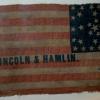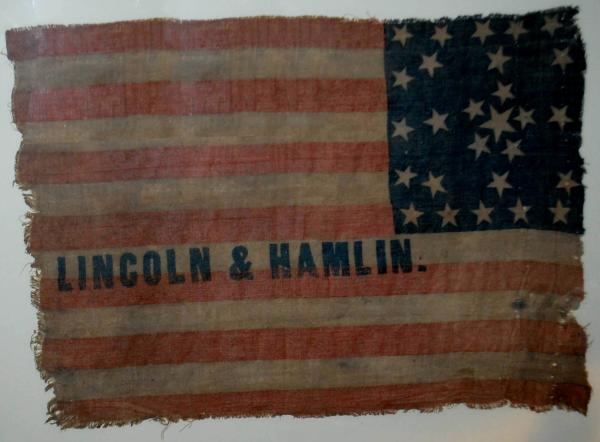Iowa's Influence on pre-Civil War tension and how it contributed to the start of the Civil War
| Grade | 9th -12th Grades | Class | U.S. History | Length of Lesson | 1-2 Days |
| Lesson Title | Iowa's Influence on pre-Civil War tension and how it contributed to the start of the Civil War |
| Unit Title | |
| Unit Compelling Question | Was the Civil War avoidable based on the conflicts occurring in America? |
| Historical Context: This flag, in the collection of the Carnegie Historical Museum, displays the names of Abraham Lincoln and Hannibal Hamlin, the Republican nominees for president and vice president in 1860. It was carried in a Wide Awakes rally held in Fairfield, Iowa, attended by close to 25,000 people. The Wide Awakes were a youth organization that supported the Republican Party during the 1860 presidential election. The organization used social events, ideas of brotherhood and even promotional comic books to promote its political ideas among younger voters. The Wide Awake was a new Republican revolutionary political organization that rose during the late 1850s. The group was attractive to young, white men in their twenties who wanted their voices to be heard in the political and social world. The group used social events such as rallies, promotional acts and even comic books, to urge young people to join and speak up against the instability seen around the country and urge the Republican party to take action. While not intending to start violent acts themselves, the group did adopt military motifs such as calling themselves the "army" and assigning ranks to the new "soldiers" that enlisted. The military theme was chosen to connect with their message of glorifying combat and to signify uniformity within the Republican Party. The organization is said to have increased the pressure and motivation to engage in war. The rallies held by the group involved loud noise coming from marching bands, while the members, dressed in black capes and hats, carried torches through city streets. ### The two decades leading up to the Civil War threatened the very existence of the United States. Sectional divisions between North and South, primarily but not exclusively, over the issue of slavery, created distrust of the national political system on both sides. Iowa quickly became embroiled in the sectional struggles. When Iowa applied for statehood in 1846, its boundary lines became an issue. Iowans wanted large-state boundaries. The South supported those because it meant fewer western free states carved out of the Louisiana Purchase, consequently fewer Northern senators in Congress. For the opposite reason, Northern interests wanted a small state and more free-state senators. After a two-year struggle, a compromise gave Iowa its current borders. A major disruption emerged in 1854 with the passage of the Kansas-Nebraska Act that potentially opened lands west of Iowa to slavery and reformed the state's political parties. The Republican Party emerged in the Midwest committed to the non-extension of slavery but not repeal where it existed. As the westernmost outpost of Northern settlers heading to "bleeding Kansas," the town of Tabor in southwest Iowa became a supply post for anti-slave forces. The militant John Brown who led an failed slave revolt in Harper's Ferry, Virginia, that inflamed the South trained his small force for months in Iowa. All across the state, the network of the underground railroad helped slaves escaping across Iowa's southern to safety enroute to Canada. While many Iowans were opposed to an extension of slavery to western territories, only a small percentage were abolitionists committed to ending slavery in the South. Quaker and Congregationalists from New England were strongest in their opposition to the South's "peculiar institution", but the large majority of Iowans were staunchly opposed to equal rights for blacks. The state passed some extremely harsh "black codes" to discourage African-American settlement. When fighting broke out at Ft. Sumter in the Charleston, SC, harbor, Iowans rallied to Lincoln's call to save the Union but they were not signing up to abolish slavery. It took four years of fighting to change attitudes to the point that black men were granted the vote in 1868. |
|
| Lesson Supporting Question | |
| Lesson Overview | Students will engage in a study of Iowa’s influence on the tensions that led to the Civil War. We will view anything from political parties to religious influence to geographical interests. Students will also connect Iowa’s interest in the United States and compare it to the other states. Finally, the students will determine if Iowa’s influence was a contributing factor in the start of the Civil War. Students will understand the nature and scope of the antislavery movement, both nationally and in Iowa, in the 1850s. Students will understand the role played by Iowans in the planning and execution of John Brown’s famous raid on Harpers Ferry, Virginia. |
| Primary Sources Used |
|
| Resources Needed | http://www.iowan.com/underground_railroad_if2005.cfm http://www.nps.gov/hafe/photosmultimedia Berrier, G. Galin. “The Underground Railroad in Iowa,” in Outside In: African American History in Iowa. Des Moines, Iowa: State Historical Society of Iowa, 2000. History of Johnson County, Iowa: 1836-1882. Portland, Indiana: Modern Pre-Binding Corporation, 1883. |
| Standard | |
| Lesson Target | Students will understand that Iowa was a complex state prior to the Civil War and made many contributions that led to the path of war. Students will know that Iowan’s had many contributions to thought prior to the Civil War and were some of the leaders in abolitionist America. Students will understand that Iowa was a pivotal state in abolitionist thought and pushed the path of the Civil War more than many think in America.;Students will know the key terminology of pre-Civil War Iowa and what they meant during that time. Students will know the important people and the key events during pre-Civil War Iowa. Students will know how to align events into a timeline and connect them to other events in the country.;Student will be able to analyze both sides of the political spectrum in Iowa prior to the Civil War. Students will be able to decode the difference in Iowan’s thoughts and why they chose the path they did prior to the Civil War. Students will be able to use technology to continue to research many factors in Iowa’s pre-Civil War involvement |
| Lesson Themes | |
|
| Formative Assessment (How will you use the formative assessments to monitor and inform instruction?) |
|
| Summative Assessment (How does the lesson connect to planned summative assessment(s)?) |
Students will write a 5-page position paper that is double-spaced and 12 point font.; Directions: Students will write a position paper that answers the essential questions. 1) How did Iowa politics play a role in supporting the path towards the Civil War? 2) What factors led to Iowa's prominence before the Civil War? 3) Did Iowa contribute to the start of the Civil War?; Students must use at least 5 outside sources and cite them in their paper in MLA Style citation and list the references at the end of the paper in that style as well. The students will have 2 days to work this outside of class. |
| Author | Eric Jones | Created | Last Edited | ||||
| Reviewer: Dr. Lisa Millsaps, University of Northern Iowa | |||||||
| Lesson Plan Development Notes: Teaching Methods, University of Northern Iowa, Fall 2018 | |||||||


